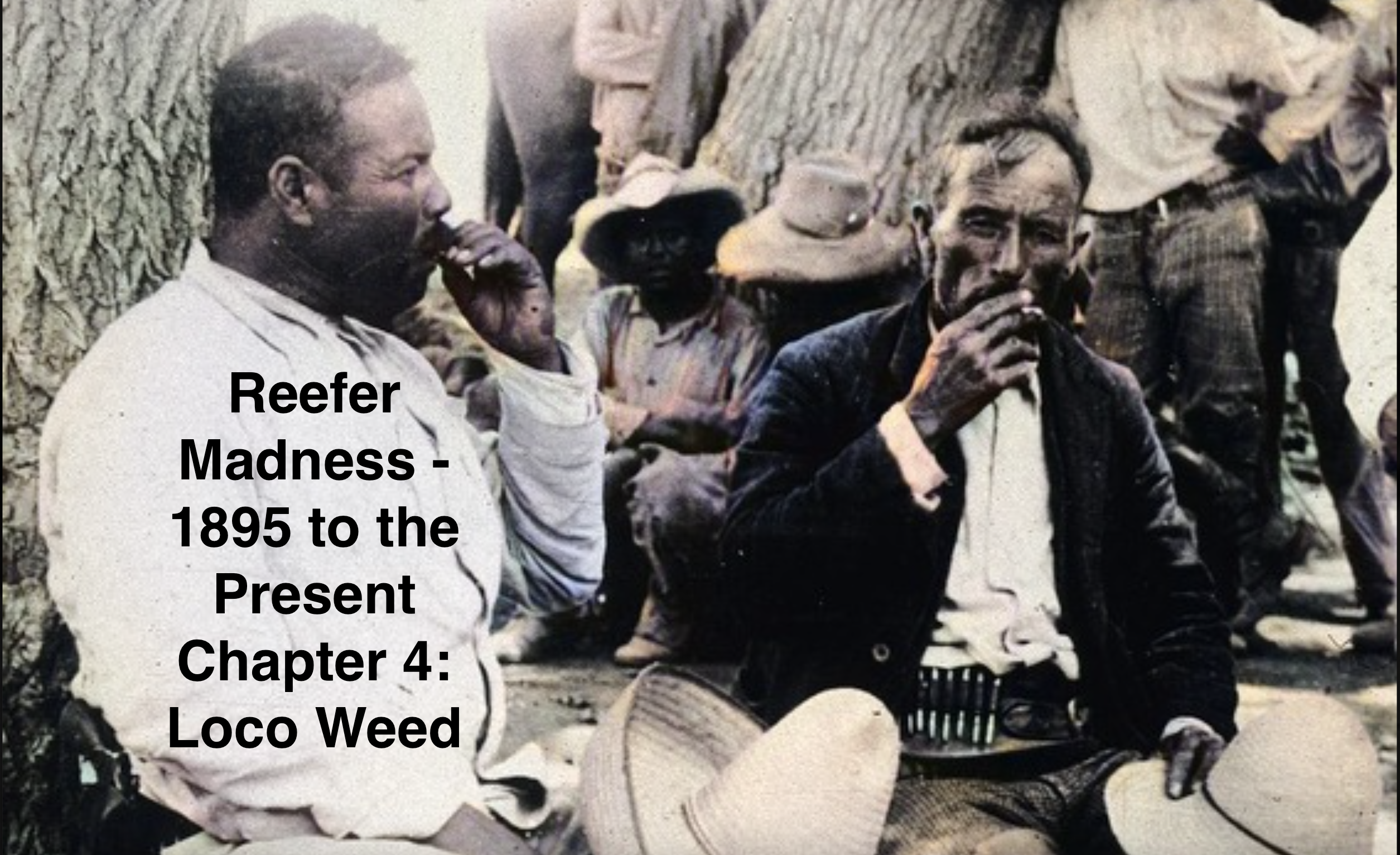Traditional Medicine Part 4: Blue Lotus & Red Lotus
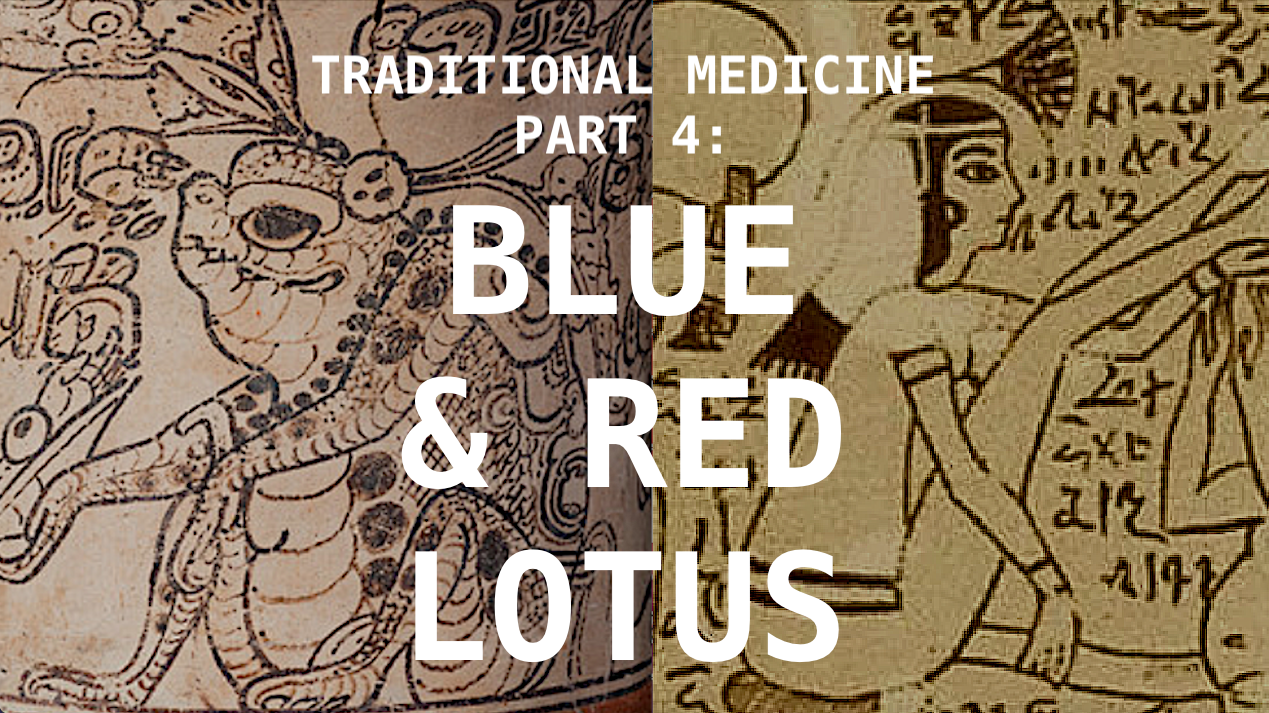
CANNABIS CULTURE – An ongoing series from Cannabis Culture regarding the applicability of UNDRIP “traditional medicine” rights of Indigenous people to the use and the economies of psychoactive and psychedelic plant drugs.
Part 1 was all about cannabis.
Part 2 looked closer at the United Nations UNDRIP treaty and at the concept of Biopiracy.
In our latest installment of this series, we look at blue lotus and red lotus – two magical flowers with medicinal powers.

Image #1: “. . . a plump toad wearing a jade bead necklace . . . The vertical text describes the vessel as one used to drink cacao (chocolate), which was first cultivated by the Maya and whose consumption was the prerogative of royalty.” https://collections.lacma.org/node/212444
“A suggestion that certain water lilies might have narcotic properties is found in their frequent use as a motif in funerary art among the Egyptians as well as Mayans. The work of Rands (1953, 1955) traced the New World distribution of water lily motifs throughout Mayan art and made important mythic associations. From the middle of the Classical period until the inception of the Mexican periods, Rands makes the association between this tradition and that in Asiatic art. . . . In extending the earlier works of Rands, Dobkin de Rios (1974, 1977) investigated the psychotropic flora and fauna in Mayan culture and noted the frequent use of the water lily motif in association with the toad (Bufo marinus). These toads contain bufotenine in glands located near the tympanum. The substance is released in the matrix of a milky exudate when the amphibian is aroused. Bufotenine is capable of inducing profound hallucinations after breaking the blood-brain barrier. This led Dobkin de Rios to the assertion that Mayan depictions of the water lily were probably more than decorative and constituted a source for the development of a belief system that could be explained, in part, on the use of the toad and the water lily to alter states of consciousness. . . . Emboden (1974) touched upon the use of Nymphaea caerulea as a narcotic and has been in contact with Dobkin de Rios concerning the use of water lilies as narcotics in the old world and especially in ancient Egypt.”
- William A. Emboden, “The Sacred Narcotic Lily Of The Nile: Nymphaea Caerulea,” 1978 (1)

Image #2: ” . . . a waterlily-toad . . .” https://www.pinterest.ca/pin/575475658631411497/
“Up to the 80s of last century, the general opinion of ethnobotanists, pharmacologists, and anthropologists was that the plants of the family Nymphaeaceae did not have any unusual pharmacological and chemical properties. This was found by Emboden (1978) to be a wrong assumption. He identified the use of certain Nymphaea species In the Ancient culture of the Mayans, and quoted a poem from that culture, praising the ‘precious aquatic flowers’ and the ‘flowers that cause vertigo, the beautiful narcotic flowers’.”
- Jan M. Keppel Hesselink, “Blue Nile Flower Rituals From the Perspective of Transpersonal Psychology – The Role of Nuciferine and its Putative Value as an Antipsychotic Drug,” 2018 (2)
There are two species of aquatic plants called lotuses (3) and 65 species of water lilies (4) (some of which look similar to lotuses and/or are also called lotuses) located all over the world. Some are white, some yellow, some blue, some purple, some red and some pink. Because there are so many types of water lilies in each colour category, it can cause confusion and mis-identification.

Image #3: https://en.wikipedia.org/wiki/Nymphaea_nouchali_var._caerulea

Image #4: https://en.wikipedia.org/wiki/Nymphaea_rubra
The beautiful Egyptian flower known as the blue lotus (Nymphaea nouchali var. caerulea) and its Asian cousin the red lotus (Nymphaea rubra) are both water lilies, both utilized all over the world, and are both typically smoked as an opium substitute or used to make into tea or soaked in alcohol and drunk as a mild relaxant, and – in the case of blue lotus – an aphrodisiac. While researching this article I have discovered that blue lotus can also be found in potent extract powder, gummies and vape cartridges, and its oils are used in perfumes and massage oil.

Image #5: https://www.joom.com/en/products/61e6aedc8882420116633a57

Image #6: https://indiabiodiversity.org/files-api/api/get/raw/img//Nymphaea%20caerulea/Nymphaea_caerulea_1.jpg

Image #7: St. Joseph News-Press, St. Joseph, Missouri, June 18th, 2008, p. B8
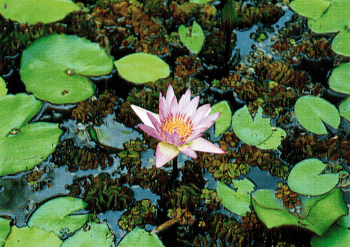
Image #8: “The blue lotus (Nymphaea caerulea) is now rare.” Nymphaea caerulea Savigny, Blue Lotus Flower, The Encyclopedia Of Psychoactive Plants, Christian Ratsch, Park Street Press, Rochester, Vermont, 2005, p. 398
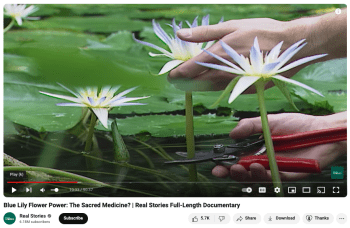
Image #9: “Blue Lily Flower Power: The Sacred Medicine? | Real Stories Full-Length Documentary” https://www.youtube.com/watch?v=-yeodYApPYk
A warning regarding lotus identification. That which is commonly sold as blue lotus is a lot darker a colour of blue than the blue lotus depicted in some ancient images or in modern documentaries. And what is called red lotus could very well be confused with a number of similarly-hued species of lotus. Plant identification is an imperfect science, and there is still much to learn about the varieties of active ingredients found in various lotuses. My advice to the reader is to learn as much as possible about the historical and biochemical differences between species of lotuses, and experiment upon yourself – carefully. Always begin with small doses, slowly increase the dose until the desired effects are felt, and make public your discoveries.

Image #10: Blue lotus (left) and red lotus (right) obtained from the Coca Leaf Café. Photo by David Malmo-Levine.
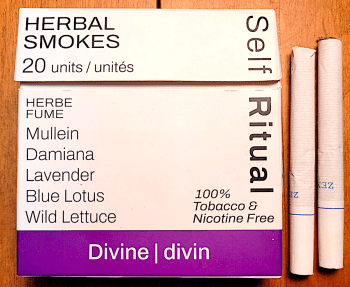
Image #11: “Divine” Self Ritual Herbal Smokes containing Mullein, Damiana, Lavender, Blue Lotus and Wild Lettuce, obtained from the Coca Leaf Café. Photo by David Malmo-Levine.
This author has been personally conducting extensive experiments on himself with the blue lotus available at the Coca Leaf Café – in small amounts – both in tea and in a herbal cigarette mixture. Personally, I’ve noticed a mild sedative effect, along with a mild enhancement of sexual hydraulics. Nothing crazy, mind you. I’m just a little bit more chill and a little bit harder.
Traditional Use – Blue Lotus:
Blue lotus is possibly the most common plant depicted in ancient Egyptian artwork. There is indication from ancient texts that blue lotus was used as a sacrament to create religious visions in ancient Egyptian rituals. (5)

Image #12: “Fragment of a Tomb Painting with Seated Woman Holding a Lotus” (detail), ca. 1539-1425 B.C.E., From the collection of Brooklyn Museum. https://artsandculture.google.com/usergallery/megan-freeman-the-lotus-flower-in-ancient-egyptian-art/SQKyjvz1wuBLLg
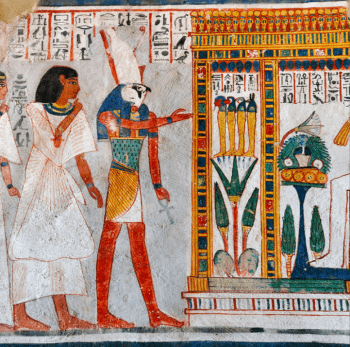
Image #13: “‘Horus in Roy’s tomb at Luxor.’ A mural detail in the tomb of Roy shows Roy, in an attitude of deep respect, being led by Horus to a golden shrine in which Osiris presides (only his legs are visible here). Before Osiris stand the Four Sons of Horus: Amseti with the human head, Hapy with the baboon head, Duamutef with the falcon head and Qebehsenuef with the dog head. They are the guardians of the canopic jars which contain the internal organs of the deceased. They are represented here on top of a lotus flower, symbol of rebirth and renewal.” (Detail) https://paulsmit.smugmug.com/Features/Africa/Egypt-Luxor-tombs

Image #14: “Tutankhamun . . . lived from 1342 – 1325 BC and ruled as a Pharoah from 1334 – 1325 BC. . . . When Carter discovered the tomb in the 20th century, he found the mummy inside three golden sarcophagi, and the mummy was decorated with splendid jewellery coloured with vibrant schemes and shaped as Lotus, Horus eyes and vulture wings.” https://bluelotusflowers.com.au/the-history-of-the-blue-lotus/
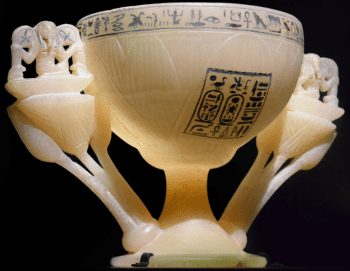
Image #15: “The Lotus chalice or Alabaster chalice, called the Wishing Cup by Howard Carter, derives from the tomb of the Ancient Egyptian pharaoh Tutankhamun of the 18th Dynasty. . . . The chalice takes the shape of a white lotus in full bloom, identified by its rounded petals. The supports for the handles are shaped like blue lotus flowers which are flanked by buds growing upward, with the god Heh seated on a basket (the neb symbol) on the tips of the petals.” https://en.wikipedia.org/wiki/Lotus_chalice
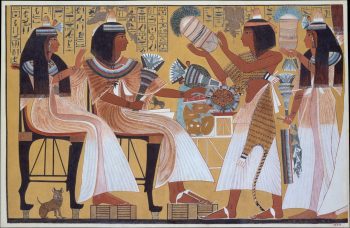
Image #16: “In Egypt, two native species of lotus grew, the white lotus (Nymphaea lotus) and the blue lotus (Nymphaea cerulea). A third type, the pink lotus (Nelumbo nucifera) was introduced to the country from Persia during the Late period. All three species were depicted in Egyptian art (the pink lotus showed up in Hellenistic artworks), however the sacred blue lotus was the flower most commonly used and the one depicted in the hieroglyph.” https://egyptianocculthistory.blogspot.com/2017/12/lecture-blue-lotus-in-ancient-egypt.html

Image #17: “Capitals mostly follow the forms of the lotus (emblem of Upper Egypt), the papyrus (emblem of Lower Egypt), and the palm . . .” Egyptian Columns Reprinted from A History of Architecture on the Comparative Method, by Sir Banister-Fletcher, New York, 1950, p. 43 https://buffaloah.com/a/archsty/egypt/bf/bf.html

Image #18: https://lampmagician.com/2020/08/08/the-lotus-more-than-a-plant-a-symbol/
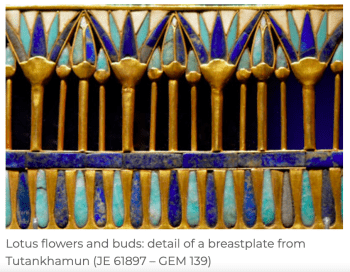
Image #19: https://lampmagician.com/2020/08/08/the-lotus-more-than-a-plant-a-symbol/
It appears that a South American cousin of the blue lotus – the dotleaf water lily (Nymphaea ampla) – also has similar active ingredients, similar effects and similar sacramental functions in the ancient Mayan religion. (6)

Image #20: “There is evidence that Nymphaea may have been employed as a hallucinogen in both the Old and New Worlds. The isolation of the psychoactive apomorphine has offered chemical support for this speculation. Nuciferine and nornuciferine are also isolated from N. ampla.” Plants Of The Gods, Richard Evans Schultes and Albert Hofmann, Healing Arts Press, Rochester, Vermont, 1992, p. 51
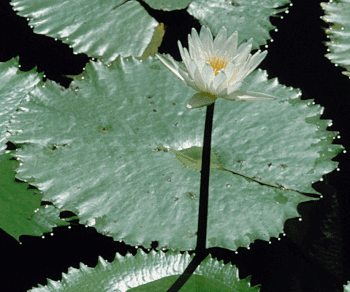
Image #21: https://en.wikipedia.org/wiki/Nymphaea_ampla

Image #22: “Maya Culture, Mexico, Male Figure Emerging from a Water Lily, 600–900 CE. Painted ceramic, 8 1/4″ x 1 9/16” (21 x 4 cm). © 2022 Brooklyn Museum. (BMA-119)” https://www.davisart.com/blogs/curators-corner/gem-of-the-month-classic-maya-jaina-island/

Image #23: Maya vessel (c. 700–800 CE) from Guatemala depicting a king sitting on a throne wearing a water lily headdress. Water lilies (Nymphaea ampla) on reservoir surfaces indicated clean water and symbolized Classic Maya kingship (c. 250–900 CE). Credit: Courtesy the Boston Museum of Fine Arts (www.mfa.org).” https://phys.org/news/2023-10-ancient-maya-reservoirs-lessons-today.html

Image #24: Journal of Ethnopharmacology, 3 (1981) 39 – 83 @ Elsevier Sequoia S.A., Lausanne – Printed in the Netherlands 39 TRANSCULTURAL USE OF NARCOTIC WATER LILIES IN ANCIENT EGYPTIAN AND MAYA DRUG RITUAL, WILLIAM A. EMBODEN https://dokumen.tips/documents/transcultural-use-of-narcotic-water-lilies-in-ancient-egyptian-and-maya-drug.html?page=1

Image #25: Journal of Ethnopharmacology, 3 (1981) 39 – 83 @ Elsevier Sequoia S.A., Lausanne – Printed in the Netherlands 39 TRANSCULTURAL USE OF NARCOTIC WATER LILIES IN ANCIENT EGYPTIAN AND MAYA DRUG RITUAL, WILLIAM A. EMBODEN https://dokumen.tips/documents/transcultural-use-of-narcotic-water-lilies-in-ancient-egyptian-and-maya-drug.html?page=1
William Emboden, for many years one of the leading researchers on psychoactive effects of the blue lotus, pointed out that it had been argued that the flower could put the user in a “shamanistic trance.” (7) Emboden wrote this about its traditional use:
“. . . I was delving into the Nymphaea caerulea of the ancient Egyptians, since it is found in so many motifs in tomb painting, on unguent vessels, in stelae, and in association with almost every sacred artifact and occasion. I was able to trace the first Old World use back to the Antilles as early as 1822, at which time Nymphaea was regarded as an effective substitute for opium. Many later reports confirmed that use. The aforementioned repeated association between this plant, the opium poppy (Papaver somniferum), plants that might have been selected for depiction, only those of some ceremonial importance would have been chosen. All three are potent narcotics and would know that the unguent jars bear opium residues, indicating that they were not for water or perfume as previously suggested by Egyptologists. Further, Nymphaea decorative motif is not reasonable in light of the total possible choices. The creation myths of the four cosmographies are evident. . . . It is the flower proper that has historically been used as a narcotic.” (8)

Image #26: “In Amarna times, when growing poppies became more frequent, princesses were very often figured holding these and other narcotic plants, such as mandrake, lilies, and so on, and offering them to their partners (Fig. 12), something that might be considered evidence of consumption.” https://brewminate.com/remedy-or-execution-poppy-and-opium-in-the-ancient-world/

Image #27: “A bunch of lotus flowers, mandrake and poppy. Tomb of Nebamun and Ipuky at Thebes (TT181).” https://www.atthemummiesball.com/poppies-ancient-egypt/

Image #28: “Tutankhamun stretching his hand to receive two bouquets of lotus, papyrus and poppies from the queen. Detail from the casket.” https://www.atthemummiesball.com/poppies-ancient-egypt/
Wikipedia has a good summary of some of the traditional uses:
“The rootstock of the blue water lily was collected and eaten in western South Africa around 1800, either raw or in curries, in particular by the Cape Malays and farming communities in the Cape, although this practice has now died out. Some evidence indicates the effects of plants including N. caerulea that contain the psychoactive alkaloid aporphine were known to the Ancient Egyptians. The mildly sedating effects of N. caerulea makes it a candidate (among several) for the fruit of the lotus tree eaten by the mythical Lotophagi (Lotus-Eaters) in Homer’s Odyssey.” (9)
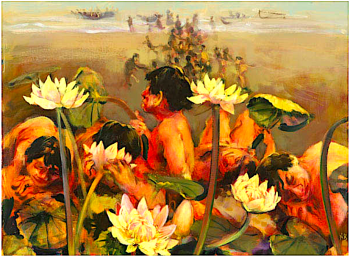
Image #29: “In the legend of the Odyssey, Book IX, while returning home to Ithaca from Troy sudden strong gusts blow Odysseus and his crew off course as they were rounding Cape Malea, the southernmost tip of Peloponnesus. The storm sent by Zeus sweeps them for nine days before bringing them to the land of the Lotus-Eaters, where his men are given some of the intoxicating fruit. In turn, Odysseus has lot drag his men back to the ship and lock them up in order to get off the island.” navigatingtheodyssey.pbworks.com/w/page/86315554/The%20Lotus%20Eaters

Image #30: “The Scene from the film Percy Jackson and the Lightning Thief where the myth of the Lotus Eaters is modernized and represented in the form of a teenage boy, Percy, on an Odyssean journey when he and his friends encounter this manipulating race of creatures in a Vegas casino.” navigatingtheodyssey.pbworks.com/w/page/86315554/The%20Lotus%20Eaters
Some researchers have pointed to both chemical and historical evidence indicating that blue lotus also has a powerful aphrodisiac effect. Another chemical found in blue lotus – one of the types of aporphines (10) – is apomorphine, which is suspected of having aphrodisiac effects:
“ . . . it has only recently become clear that apomorphine can be utilized, with excellent results, to treat erectile dysfunction. It is a centrally acting, selective D1/D2dopamine agonist, and activation of dopaminergic receptors in the paraventricular nucleus of the hypothalamus initiates a cascade of events, ultimately resulting in smooth muscle relaxation and vasodilatation within the corpora cavernosa, leading to penile erection. This discovery provides a likely explanation for the appearance of Nymphaea in the Luxor frescoe and in erotic cartoons such as that reproduced in Figure 1. The fact that temple drawings only depict use by the higher castes, such as priests and royalty, suggests that the masses did not benefit from this discovery. The Nymphaea story serves as a further illustration of how the effects of substances of plant origin were known even though the discoverers lacked the technology to explain them.” (11)

Image #31: “A fragment of the frescoes on the wall of the tomb chapel of Nebamun, depicting guests, servants, musicians, and dancers at a funerary banquet.” https://en.wikipedia.org/wiki/Dance_in_ancient_Egypt

Image 32: https://www.researchgate.net/publication/8898592_Nymphaea_cults_in_ancient_Egypt_and_the_New_World_A_lesson_in_empirical_pharmacology
The blue lotus is prominently displayed in the Turin Erotic Papyrus, an 1150 BCE scroll-painting (12) which is a famous early example of a depiction of erotic activity. (13)

Image #33: “Detail of the Turin erotic satirical papyrus.” https://egypt-museum.com/turin-erotic-satirical-papyrus/
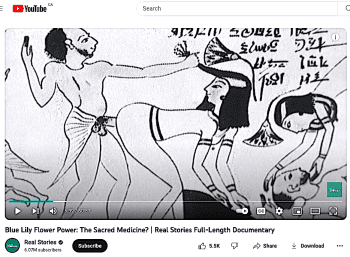
Image #34: “Blue Lily Flower Power: The Sacred Medicine? | Real Stories Full-Length Documentary” https://www.youtube.com/watch?v=-yeodYApPYk
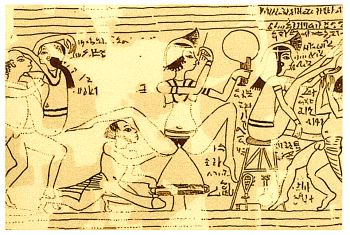
Image #35: “As a result, during the 1820’s, among a huge collection excavated from the Valley of the Kings and resting inside the safety of the walls of the newly opened Egyptian Museum of Turin, a very intriguing artifact was found. It is known as the Turin Erotic Papyrus. Concealed since until the seventies due to its “obscene” depictions, this document completely changed our western perception of Ancient Egypt. This 8.5-inch papyrus is divided into two main topics: on the one hand, one-third depicts human-like animals performing human activities, which are thought to be a satirical depiction of everyday life. The other two-thirds –and the most interesting ones– portray twelve scenes of people performing sexual positions.” https://culturacolectiva.com/en/history/ancient-egypt-turin-erotic-papyrus/
Traditional Use – Red Lotus:
Red lotus has a long history as ayurvedic medicine in India, (14) and the lotus is depicted in many ancient religious temples and works of art, however most of these images are probably renditions of the true lotus – Nelumbo nucifera – which happens to have a pink hue. The website Smoking Blends has a concise summary of red lotus’s traditional use:
“Red Lotus has a long history of use in Ayurvedic medicine to assist in treating a wide number of issues. Ranging from its use in a poultice to treating skin inflammation to being used is a gargle for sore throats.” (15)

Image #36: “The Buddha’s mother, Queen Maya, Illustrated by elephants. Sanchi, Stupa 3 gateway, probably 1st century CE” https://en.wikipedia.org/wiki/Lotus_throne

Image #37: “An Indian lotus motif on a Hindu temple. Nelumbo nucifera is also the national flower of India.” “The flavonol miquelianin, as well as the alkaloids (+)-(1R)-coclaurine and (−)-(1S)-norcoclaurine, can be found in the leaves of N. nucifera.[69] The plant also contains nuciferine, neferine, and many other benzylisoquinoline alkaloids with medicinal properties.” https://en.wikipedia.org/wiki/Nelumbo_nucifera

Image #38: “Wat Mahathat also features over 200 subordinate (smaller & less important) chedis and a beautiful surrounding moat filled with (often) blooming red water lilies (nymphaea rubra). You can see the lily-filled moat in the first Wat Mahathat image above.” https://www.twobirdsbreakingfree.com/ultimate-guide-to-sukhothai
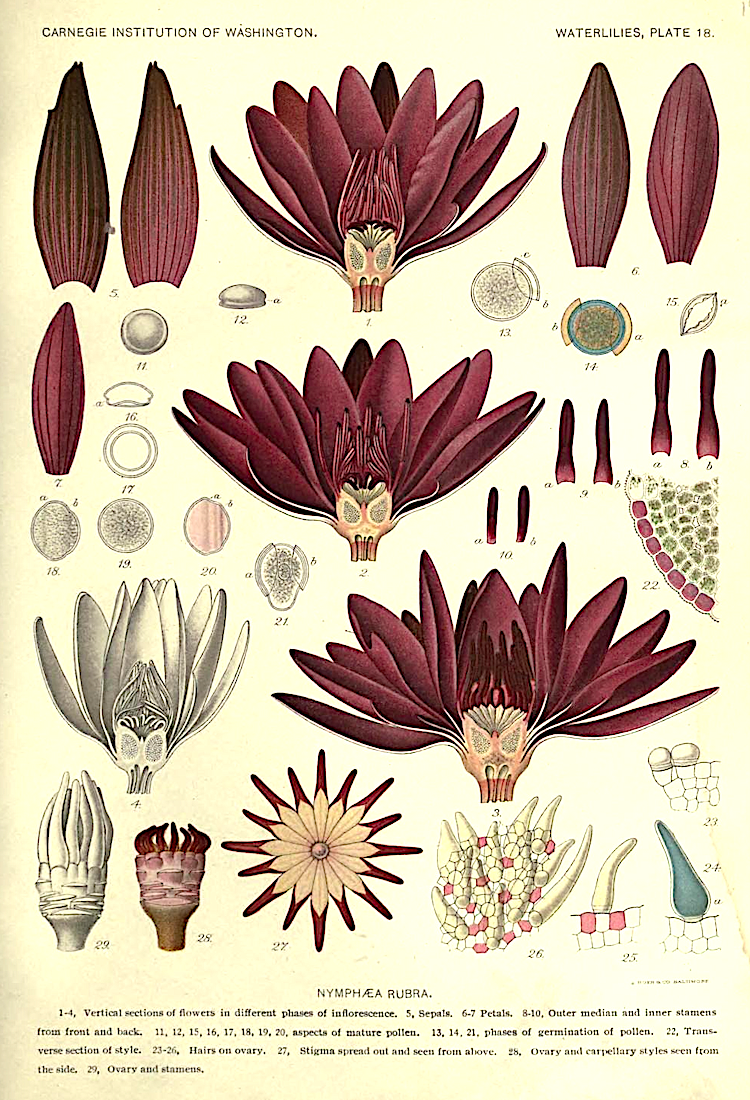
Image #39: Botanical illustration of Nymphaea rubra in the publication The waterlilies: a monograph of the genus Nymphaea by Henry Shoemaker Conard, 1905, plate 18, p. 258. https://archive.org/details/waterliliesmonog00conruoft/page/258/mode/2up

Image #40: Nymphaea rubra, red indian water lily, plate 1160 from the Fleming Indian Drawings Collection, c. 1790. Held in the Botany Library at the Natural History Museum, London https://www.prints-online.com/nymphaea-rubra-red-indian-water-lily-40246-8622282.html

Image #41: “Title: Red lotus and fish Artist: Tang Guang (Chinese, ca. 1670–1690) Period: Qing dynasty (1644–1911) Culture: China” https://www.metmuseum.org/art/collection/search/754013

Image #42: “While it’s beautiful at any time of day, it’s really at its most stunning around sunrise. This is generally sometime around 6 a.m. in Udon Thani in January and February, which means you should leave the city center well before 5. . . . the flowers only bloom in January and February . . .” https://thailandstartshere.com/2023/09/17/where-is-the-red-lotus-sea/#jan
Its reputation and a relaxant and opium-substitute may have come more recently (see current medical applications below).
Current Medical Applications – Blue Lotus:
Today, it is a known fact that both the blue lotus (Nymphaea caerulea) and the Indian lotus (Nelumbo nucifera) containe nuciferine, a chemical which has demonstrated anti-inflammatory, anti-cancer, anti-psychotic and pain-killing effects in animal studies. (16) Blue lotus also contains apomorphine, which is primarily used to treat Parkinson’s disease, but is also used as a sleep aid and anxiety reliever. (17)

Image #43: “Blue Egyptian water-lily (Nymphaea caerulea) from The Temple of Flora.” https://www.themarginalian.org/2022/11/07/the-temple-of-flora-thornton/

Image #44: “Nymphaea Caerulea. Blue Water-Lily. [Blue Lotus] Sydneham Edwards (1768 – 1819) Fine original hand coloured botanical illustration of the Blue lotus or blue Egyptian lotus. Modern binomial name: Nymphaea Caerulea. From Curtis’s Botanical Magazine: or, Flower-Garden Displayed.” https://antiqueprintmaproom.com/product/banksia-ericaefolia-heath-leaved-banksia-34822/

Image #45: https://www.facebook.com/thealchemistskitchen/photos/a.704960142981541/2630817297062473/?type=3
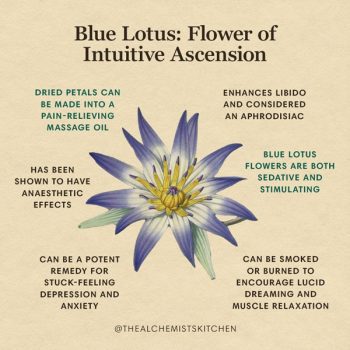
Image #46: https://wisdom.thealchemistskitchen.com/blue-lotus-flower-of-intuitive-ascension/
Emboden has highlighted how important dose is in obtaining the desired psychoactive effects of the blue lotus:
“A recent report on the effects of apomorphine indicates that in low doses it is useful in overcoming schizophrenia, but in higher doses it is able to provoke psychotic episodes. Thus, the collective chemistry of Nymphaea species is such that it is easy to conceive of their importance in the shamanic structures of both Mayan and Egyptian civilizations.” (18)

Image #47: https://www.elevatesupplements.co.za/products/blue-lotus-gummies
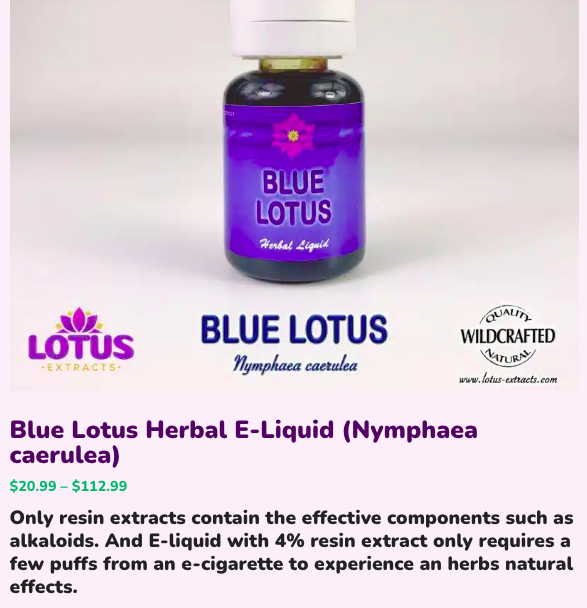
Image #48: https://lotus-extracts.com/product/blue-lotus-nymphaea-caerulea-herbal-e-liquid/

Image #49: https://the-qi.com/products/organic-blue-lotus-flower-tea?sscid=11k8_o5kgt&

Image #50: https://www.com/products/blue-lotus-extract-powder-200-1-ships-free-us-seller
Today, the flowers of the water lilies in general are developing a reputation for having aphrodisiac powers. (19) One of the chemical constituents of blue lotus – apomorphine – was once touted (20) as the active ingredient in the next wave of drugs to treat impotence. (21)

Image #51: https://bchealth.com/uprima-and-topiglan-for-erectile-dysfunction

Image #52: www.arabmedicare.com/pharmalaunch.htm
Initial clinical trial results indicated that apomorphine acted on both the penis and the clitoris, (22) but “ED patients” (all men, one assumes) preferred existing ED drugs, (23) and the only pharmaceutical apomorphine impotence drug – Uprima – was discontinued in 2006. (24)

Image #53: How The Narcotic Blue Lotus Seduced Ancient Egypt | Private Lives Of The Pharaohs | Timeline – World History Documentaries, 2023 https://www.youtube.com/watch?v=WD134i-Lzsg
Other chemicals found in blue lotus are quercetin, kaempferol and myricetin – three bioflavonoids found in many foods and herbal medicines, such as ginseng and ginkgo biloba. A documentary on YouTube about blue lotus mentioned these chemicals has having aphrodisiac properties:
“Well I think you’ve established that the chemistry of the two (blue lotus and ginkgo biloba) is fairly similar – particularly around the flavonoid region. And it looks like the lily is even richer in these flavons than ginkgo itself, which suggests that the ancient Egyptians would use it in a similar way to that which we use ginkgo for nowadays. And we are using ginkgo for a lot of different conditions but the main ones are probably for age-related deteriorations. It’s known as a kind of anti-aging herb – it’s a free-radical scavenger and anti-oxidant. And it’s particularly been shown to be useful in mild Alzheimer’s and memory disfunctions . . . and various conditions where blood flow is at fault so . . . migraine, tinnitus and so forth . . . and that would even involve the sort of Viagra-like effect . . . which will be just as important for women as men.” (25)
Current Medical Applications – Red Lotus:
According to recent molecular analysis, Nymphaea rubra is a hybrid of the European white water lily (Nymphaea alba) and the American white water lily (Nymphaea odorata). (26) Both N. alba and N. odorata have many medicinal uses, and both contain nupharine (27) which is also found in the yellow water lily (Nuphar lutea) and “said to have opium-like effects and to induce trancelike states.” (28)

Image #54: https://prithvimart.com/products/dr-willmar-schwabe-india-nymphaea-odorata-mother-tincture-q

Image #55: “SBL Nymphaea Odorata Dilution is a multipurpose health tonic which is used to treat gastrointestinal, genital and bronchial complications. It is also used for the treatment of lesions, inflammation of the mucous membranes . Skin ailments like acne and pimple eruptions are also healed using this medicine.” https://www.1mg.com/otc/sbl-nymphaea-odorata-dilution-30-ch-otc355245
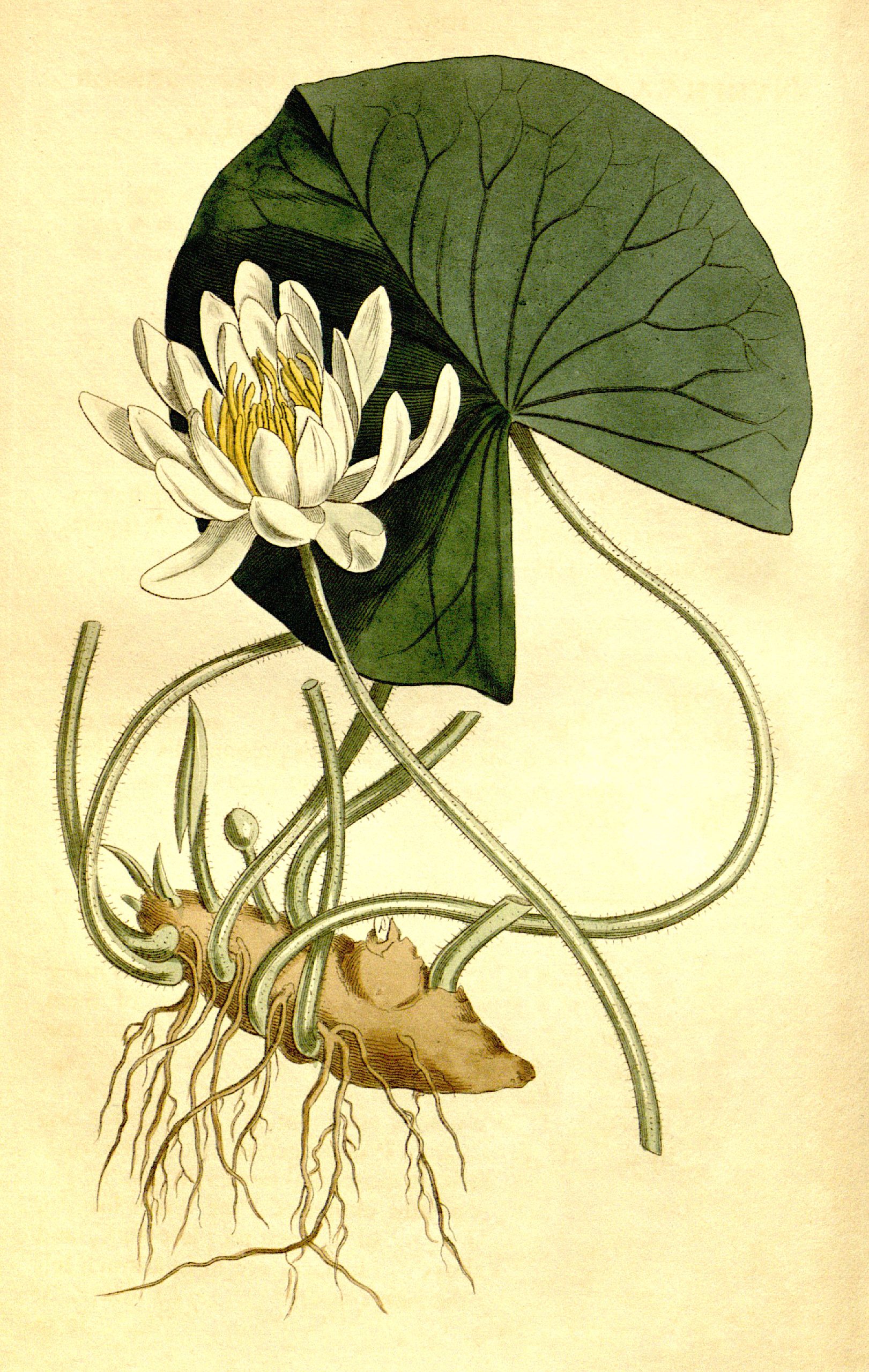
Image #56: Nymphaea odorata subsp. odorata, 1814 https://en.m.wikipedia.org/wiki/File:Nymphaea_odorata_Bot._Mag._40._1652._1814.jpg
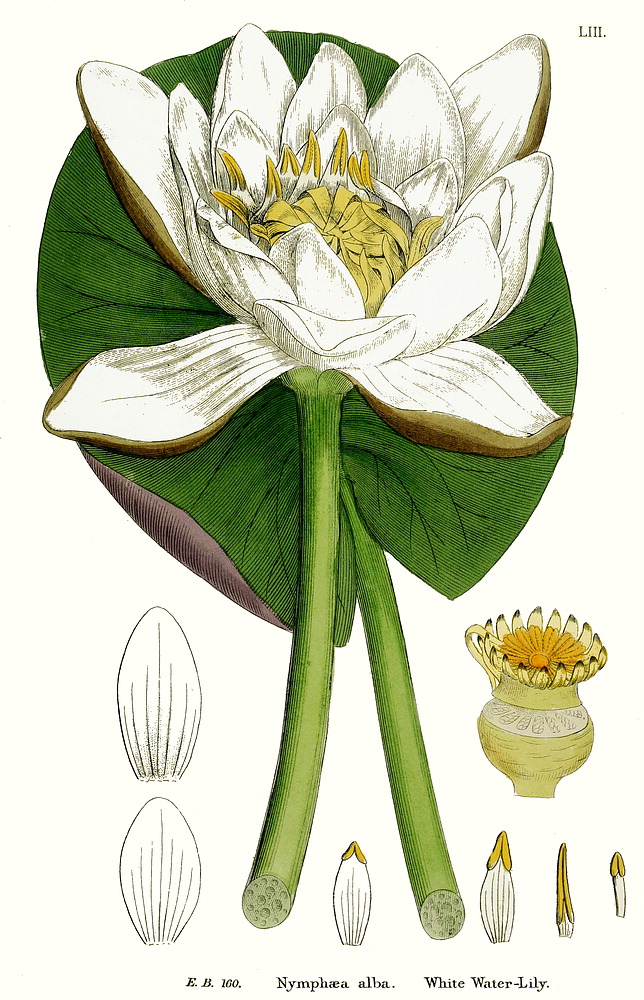
Image #57: “Considered to be a sedative, anesthetic, astringent, antiseptic and an aphrodisiac. Cultivated as ornamental, Flowers used in decoration and worship.” Nymphaea alba L. https://indiabiodiversity.org/species/show/230482

Image #58: “This powerful plant has been used for spiritual and ceremonial purposes for centuries. A few leaves of the White Lotus will alter your consciousness with insight, relaxation, and sexual excitement.” https://www.dutch-headshop.eu/white-water-lily-nymphaea-alba-indian-spirit-25-grams

Image #59: “Sore throat – Insomnia, anxiety” https://aromacentre.fr/gelules-de-plantes/2539-nenuphar-racine-gelule-nymphaea-alba-200mg-herbacum.html
Nymphaea rubra has retained both the general medicinal utility reputation (29) and the opiate-like reputation (30) of its parents, as well as the apparent ability to produce or enhance dreams, and even act like a mild psychedelic drug at higher doses:
“The red lotus (Nymphaea Rubra) is a close relative of the more well-known blue lotus flower (Nymphaea caerulea). Both species contain psychoactive alkaloids with effects comparable to opiates. Red lotus is calming and euphoric in lower doses and sedative and oneirogenic (dream enhancing) in higher doses. Some users even report mildly psychedelic effects after smoking several rounds of red lotus flower.” (31)

“Image #60: “Nymphaea rubra flowers (NRF) are widely used as a food and in folk medicine throughout the subtropical regions due to their health-promoting characteristics. This study characterized the phytochemical composition of various extracts/fractions of NRF by establishing a quadrupole–cyclic ion mobility–time-of-flight (Q-cIM-TOF) mass spectrometry method in both positive and negative electrospray ionization modes. Over 100 phytoconstituents were tentatively identified, among which 53 phytochemicals belonging to phenolic acids, tannins, flavonoids, terpenoids, alkaloids, xanthones, and naphthopyrones have never been documented in NRF before. . . . The findings highlight the value of NRF as a source of functional components and broaden its potential applications in the food and nutraceutical industries.” https://www.sciencedirect.com/science/article/abs/pii/S0308814622025067

Image #61: “Red Lotus, Nymphaea rubra, 2X Tincture / Liquid Extract ~ Schmerbals Herbals” https://www.schmerbals.com/products/red-lotus-nymphaea-rubra-2x-tincture-liquid-extract
Safety Profiles – Blue Lotus:
Five military men on five separate occasions were admitted to emergency department of a military hospital from the use of blue lotus vapes and tea – suffering from “sedation and perceptual disturbances” – one of whom also had a “persistent erection.” (32)

Image #62: “Toxicity From Blue Lotus (Nymphaea caerulea) After Ingestion or Inhalation: A Case Series” https://academic.oup.com/milmed/article/188/7-8/e2689/6338457
Given the fact that humans and rats have different physiologies and different reactions to different drugs, the following information is of limited value. That being said, acute and chronic toxicity studies of Nymphaea nouchali in rats revealed no signs of toxicity even at high levels of testing (2000mg/kg b.w.). (33) A similar toxicity study on mice revealed no toxicity at even higher levels of testing (3000mg/kg b.w.). (34)
When mixing with alcohol, moderation is recommended, as a “significant loss of blood pressure in some patients” was recorded when apomorphine was mixed with ethanol in clinical studies of apomorphine as an aphrodisiac. (35)
Safety Profiles – Red Lotus:
Red lotus displayed similar toxicity study results, with “animals” showing no signs of toxicity or mortality (in tests of up to 2000 mg/kg b.w.). (36)
Legal Status – Blue Lotus:
Blue lotus was recently (2009) made illegal in Poland, Russia, Latvia (37) and (in 2005) Louisiana – “if (cultivated, bought, sold, or traded) done for human consumption.” (38)
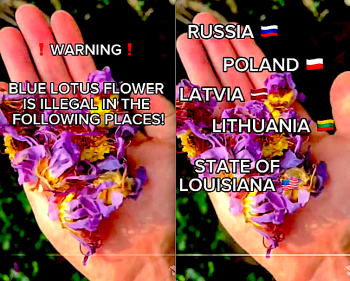
Image #63: https://www.tiktok.com/@bluedreamtea.co.uk/video/7272490662392630561
Legal Status – Red Lotus:
This author could find no examples of prohibited red lotus sales, imports or possession.
This author did find one example of “lotus flower capsules” that were deemed illegal to import or possess in Australia due to a dangerous and undisclosed adulterant – a derivative of fenfluramine – being found within them by the Australian Department of Health and Aged Care. (39)

Image #64: https://www.tga.gov.au/news/safety-alerts/lotus-flower-capsules
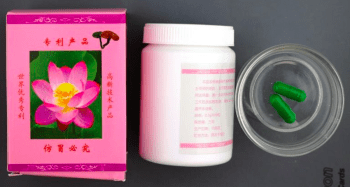
Image #65: https://www.tga.gov.au/media/12367
In the opinion of this author, all herbs should be treated like red lotus – zero prohibitions on use, no exclusive rights associated with cultivation, importation or retail, and vigorous enforcement of organic standards and regular inspections to prevent the prohibition of dangerous adulterants and contaminants.
Biopiracy Activity – Blue Lotus:
A concoction consisting of blue lotus extract (Nymphaea caerulea) along with a poppy extract (Papaver rhoeas) and marshmallow extract (Althea officinalis) was patented in Spain in 2005 as an antispasmodic skin cream. (40) Other blue lotus extract skin-related patents were approved in China – one in 2013 and one in 2019. (41)
In cases such as the above skin medicines, patent holders may have selected particular target ailments or certain combinations of extracts in order to avoid “prior art” challenges to their patents, but the use of the lotus for skin medicines is nothing new. The 1894 U.S. National Dispensatory mentioned that Nymphaea alba has been an ingredient in ointments. (42) The Encyclopedia of Psychoactive Plants mentions that the petals of blue lotus were used “externally” in ancient Egypt. (43) Ancient Egyptian “unguent” (ointment) spoons were often decorated with blue lotus motifs. (44)

Image #66: “ointment-spoon; cosmetic-tool/implement” https://www.britishmuseum.org/collection/object/Y_EA5966
Biopiracy Activity – Red Lotus:
A 2018 Chinese patent exists for “a kind of nymphaea rubra method of extraction of essential oil” (45) which, because of the difficulty in perfectly translating from Chinese to English, is a challenge to understand fully. This author gathers that it involves taking an already-patented method of extracting essential oils from Nymphaea rubra and applying it to Nymphaea tetragona (pigmy waterlily/small white waterlily) using the following steps:
Step 1: “nymphaea tetragona is taken, drying is crushed, obtains water lily powder”
Step 2: “ultrasound-enhanced sub-critical extraction technology is utilized, raw material is extracted with extractant, obtains essential oil paste”
Step 3: “essential oil paste is dissolved with organic solvent, filters, obtains filtrate” and
Step 4: “filtrate obtains essential oil product after rotary evaporation.” (46)
Drying plants and using solvents and filters to obtain extracts are all ancient technologies. Rotary evaporation was commercially available back in 1957. (47) The process of using ultrasound to extract essential oils – sonication – is a more recent technology – it appears go back to at least 2014. (48)

Image #67: “Chemical Composition, Market Survey, and Safety Assessment of Blue Lotus (Nymphaea caerulea Savigny) Extracts” https://www.mdpi.com/1420-3049/28/20/7014#
Perhaps combining these various processes in a new way allows one to apply for a patent, so not only can new technology be patented but new combinations of processes. On the surface, it appears that the only truly novel thing about this patent is the switching out of one main ingredient (Nymphaea rubra) for another (Nymphaea tetragona).
Ingredient-switching is one method of meeting the “novelty” element of a patent. Another method is to simply disguise ancient extracts by their modern scientific names. For example, “oil of wintergreen” is now known as “methyl salicylate”. (49)
In an even sneakier move, an article on COVID patents mentions “nupharin” (50) which can be used as a synonym for “nupharine” (51) (one of the active ingredients in red lotus) without mentioning red lotus, or Nymphaea rubra, thus avoiding some of the scrutiny it might have received otherwise.
On the surface, it seems the plant medicine patent community is counting on the traditional medicine community to not spend too much time researching (or questioning or even challenging) the things they are writing about (and doing), in the hopes that their fancy new ointments and cold and fever medicines aren’t compared too closely with ancient versions.
Hopefully, research projects such as the Indian (52) and Southeast Asian (53) “Traditional Knowledge Digital Libraries” can act as a guard against unwarranted claims of “novelty” for ancient medicines and prevent biopiracy (54) and medical monopolies getting in the way of people’s access to beneficial medicines.
In Conclusion
In conclusion, this author is not entirely certain about what the true nature of the commercially-available blue lotus and red lotus are – whether they are genuinely safe and effective, what their active ingredients actually are, or even if they have been properly identified. But the above information indicates that there is good reason to look into these matters further.
The potential benefits of other non-toxic relaxants and/or aphrodisiacs aside from cannabis that one can smoke, drink in tea or use in a wine infusion are – in the case of the blue and red lotus – understated, and these beautiful flowers could easily become both a great medicinal tool and a great financial boon for all of humanity, so long as the blue lotus and red lotus are fully researched, used properly and to their maximum benefit, and exclusive economic relationships are prevented.
Stay tuned to Cannabis Culture for the next stop on our tour of Indigenous traditional medicines: coca.
Citations:
1. Emboden W A. The sacred narcotic lily of the Nile: Nymphaea caerulea, (1978) Economic Botany 32: 395-407 https://www.jstor.org/stable/4253981
2. Keppel Hesselink JM. Blue nile flower rituals from the perspective of transpersonal psychology- the role of nuciferine and its putative value as an antipsychotic drug (2018) Edelweiss Psyi Open Access 1: 22-24
https://www.researchgate.net/publication/332025224_Blue_Nile_Flower_Rituals_from_the_Perspective_of_Transpersonal_Psychology_-_The_Role_of_Nuciferine_and_its_Putative_Value_as_an_Antipsychotic_Drug
3. https://en.wikipedia.org/wiki/Nelumbo
4. https://en.wikipedia.org/wiki/Nymphaea
5. “A more personal and detailed account of a libation ceremony is described in a relatively late Demotic text (3rd c. CE; (Betz 1986, PDM xiv. 1–92)) that describes a young initiate’s experience of ecstatic exhilaration upon drinking the sacramental beverage. The initiate relates that he is transported to the primeval waters and netherworld of the gods after transforming himself into a ram-lion-lotus god known as Amun. Proclaiming the secrets of the underworld have been revealed to him and that the libation has opened his eyes to the divine light of a lotus flower, his soul ascends from the netherworld into a celestial sphere of light, upon which he shouts, ‘Oh Lotus, open to me heaven in its breadth and height! Bring me the light which is pure’ (Betz 1986, PDM xiv. 862–65). Euphoric experiences of such type lend credence to the perennial hypothesis that psychoactive principles of water lilies were possibly employed as a shamanic medium.”
“Influences of Egyptian Lotus Symbolism and Ritualistic Practices on Sacral Tree Worship in the Fertile Crescent from 1500 BCE to 200 CE,” J. Andrew McDonald, Department of Biology, The University of Texas, Religions, 2018, 9(9), 256
https://www.mdpi.com/2077-1444/9/9/256
See also:
“Michael Carmichael suggested that the psychoactive effects of the blue lily and other psychoactive plants established a new foundation for understanding the origins of philosophy and religion in ancient Egypt.”
https://en.wikipedia.org/wiki/Sacred_Weeds
Blue Lily Flower Power: The Sacred Medicine?
https://www.youtube.com/watch?v=-yeodYApPYk
6. “Nymphaea ampla is widely represented in Mayan art, especially in its depictions with jaguars and Mayan kings. Its cultural importance can be seen in one of the Mayan names of the plant; nikte’ha’ (‘vulva of the water’) as it would have represented life, sexual activity, fertility, and birth. The plant causes opiate-like effects on the user and is known to have been used as a calmative and mild trance inducer.” https://en.wikipedia.org/wiki/Nymphaea_ampla “Awareness of the effects of apomorphine on the brain probably extends back to ancient civilisations. The bulbs and roots of the water lily species (Nymphaea caerulea, the blue lotus and Nymphaea ampla, which has a white flower) are now known to contain a wide range of aporphines including apomorphine. Ethno-botanical scholars have suggested that the Nymphaea species were employed for their narcotic, aphrodisiac and hallucinogenic properties in magical-religious rites by the Maya civilisation of Central America (2000 BC–250 AD).” “Erich Harnack (1852–1915) and a Short History of Apomorphine,” Pille Taba; Andrew Lees; Gerald Stern, Eur Neurol (2013) 69 (6): 321–324., MARCH 14 2013 https://karger.com/ene/article/69/6/321/125111/Erich-Harnack-1852-1915-and-a-Short-History-of
7. “Based on an extensive review of these two powerful narcotic (i.e., hypnotic) plants (the water lily and the mandrake) in iconography and ritual, it is argued that the dynastic Egyptians had developed a form of shamanistic trance induced by these two plants and used it in medicine as well as healing rituals.”
“The sacred journey in dynastic Egypt: shamanistic trance in the context of the narcotic water lily and the mandrake,” W. Emboden, J Psychoactive Drugs . 1989 Jan-Mar;21(1):61-75
https://pubmed.ncbi.nlm.nih.gov/2656953/
8. William Emboden, Narcotic Plants – Revised and Enlarged, Macmillan Publishing Co., Inc., New York, 1979, pp. 12-13
9. https://en.wikipedia.org/wiki/Nymphaea_nouchali_var._caerulea
10. “A specific type of aporphine is apomorphine. The compound is historically a morphine decomposition product made by boiling morphine with concentrated acid, hence the -morphine suffix. Contrary to its name however, apomorphine doesn’t actually contain morphine or its skeleton, nor does it bind to opioid receptors. The apo- prefix indicates that it is a morphine derivative. Historically, apomorphine has been tried for a variety of uses, including as a way to relieve anxiety and craving in alcoholics, an emetic (a vomit-inducer), for treating stereotypies (repeated behaviour) in farmyard animals, and more recently in treating erectile dysfunction. It was also used as a private treatment of heroin addiction, but there is no clinical evidence that apomorphine is an effective and safe treatment for opiate addiction. Currently, apomorphine is used in the treatment of Parkinson’s disease.” https://en.wikipedia.org/wiki/Aporphine
11. “Nymphaea cults in ancient Egypt and the New World: a lesson in empirical pharmacology,” Elisabetta Bertol PhD, Vittorio Fineschi MD, PhD, Steven B Karch MD, Francesco Mari PhD, Irene Riezzo MD, J R Soc Med 2004; 97: 84–85
https://www.researchgate.net/publication/8898592_Nymphaea_cults_in_ancient_Egypt_and_the_New_World_A_lesson_in_empirical_pharmacology
12. “The final two thirds of Turin Erotic Papyrus consist of a series of twelve vignettes showing men and women in various sexual positions. The men in the illustrations are ‘scruffy, balding, short, and paunchy’ with exaggeratedly large genitalia and do not conform to Egyptian standards of physical attractiveness. The women are nubile, and they are shown with objects from traditional erotic iconography, such as convolvulus leaves and, in some scenes, they are even holding items traditionally associated with Hathor, the goddess of love, such as lotus flowers, monkeys, and sistra.” https://en.wikipedia.org/wiki/Turin_Erotic_Papyrus
13. https://en.wikipedia.org/wiki/History_of_erotic_depictions See also: “The women are nubile,[4][5] and they are shown with objects from traditional erotic iconography, such as convolvulus leaves and, in some scenes, they are even holding items traditionally associated with Hathor, the goddess of love, such as lotus flowers, monkeys, and sistra.” https://en.wikipedia.org/wiki/Turin_Erotic_Papyrus
14. “In the traditional ayurvedic medicine system various parts of N. rubra has been reported to treat various types of bleeding disorders (Sonowal and Barua, 2011). In addition to this, pulverized rhizomes mixed with honey have been used as therapeutic agent for bleeding nose, piles, dysentery and as cardiotonic (Yumnam et al., 2012).”
“Regulatory Toxicology and Pharmacology Acute and sub-acute toxicological evaluation of lyophilized Nymphaea x rubra Roxb. ex Andrews rhizome extract,” Kushal Kumar, Sabeena Sharma, Ashish Kumar, Pushpender Bhardwaj, Kalpana Barhwal, Sunil Kumar Hota, Regulatory Toxicology and Pharmacology Volume 88, August 2017, Pages 12-21 https://www.sciencedirect.com/science/article/abs/pii/S0273230017300934
15. https://www.smokingblends.com/product/red-lotus-flowers-petals-stamens-nymphaea-rubra/
16. “Nuciferine is an alkaloid found within the plants Nymphaea caerulea and Nelumbo nucifera. . . . Nuciferine has been reported to have various anti-inflammatory, possibly mediated via PPAR delta activation Nuciferine suppresses the SOX2-AKT/STAT3 signaling pathway in animal models. Targeting SOX-2 pathways in human models with Nuciferine may offer a novel therapeutic approach for cancer treatment. According to a newer study from 2016, Nuciferine acts as an antagonist at 5-HT2A, 5-HT2C, and 5-HT2B receptors, an inverse agonist at the 5-HT7 receptor, a partial agonist at D2, D5, and 5-HT6 receptors, and an agonist at 5-HT1A and D4 receptors. Additionally, it inhibits the dopamine transporter (DAT). In rodent models relating to antipsychotic drug effects, Nuciferine has shown various actions such as blocking head-twitch responses and discriminative stimulus effects of a 5-HT2A agonist, enhancing amphetamine-induced locomotor activity, inhibiting phencyclidine (PCP)-induced locomotor activity, and restoring PCP-induced disruption of pre-pulse inhibition without inducing catalepsy. Nuciferine may also potentiate morphine analgesia. The median lethal dose in mice is 289 mg/kg. It is structurally related to apomorphine and other aporphine derivatives.” https://en.wikipedia.org/wiki/Nuciferine
17. “The blue lotus flower (Nymphea caerulea) is an Egyptian water lily containing apomorphine and nuciferine. Apomorphine has been described as a psychoactive alkaloid and is a non-selective dopamine agonist primarily used to treat Parkinson’s disease as it stimulates dopamine receptors and improves motor function. Nuciferine is an alkaloid associated with dopamine receptor blockade. Today, blue lotus flower is used as a sleep aid and anxiety reliever.”
“The Blue Lotus Flower (Nymphea caerulea) Resin Used in a New Type of Electronic Cigarette, the Re-Buildable Dripping Atomizer,” Justin L. Poklis, B.S., Haley A. Mulder, B.S., Matthew S. Halquist, Ph.D., Carl E. Wolf, Ph.D., Alphonse Poklis, Ph.D., and Michelle R. Peace, Ph.D.
J Psychoactive Drugs. 2017 Jul-Aug; 49(3): 175–181. Published online 2017 Mar 7
https://www.ncbi.nlm.nih.gov/pmc/articles/PMC5638439/
18. William Emboden, Narcotic Plants – Revised and Enlarged, Macmillan Publishing Co., Inc., New York, 1979, pp. 12-13
19. “A decoction of the flower is given for palpitation of the heart. It is also supposed to be a blood purifier and aphrodisiac.
“Phytochemistry and Pharmacology of the Genus Nymphaea,” E. Selvakumari, A. Shantha, C. Sreenath Kumar and T. Purushoth Prabhu, Journal of Academia and Industrial Research (JAIR) Volume 5, Issue 7, December 2016
jairjp.com/DECEMBER%202016/02%20SELVAKUMARI.pdf
20. “Modern drugs used to treat erectile dysfunction act locally to facilitate penile smooth muscle relaxation, but a new generation of centrally acting agents is in clinical trials. One of these, apomorphine, a dopamine receptor agonist, was recommended in 2000 by a committee of specialists at the US Food and Drug Administration (FDA) as a treatment forimpotence.1We describe here evidence that the treatment of erectile dysfunction with apomorphine is not new: the Mayans and ancient Egyptians were well acquainted with the clinical effects of an apomorphine-containing plant, and they probably used that plant as an aid to sexual activity. Nymphaea caerulea (blue lotus) and N. ampla, which has a white flower but a similar alkaloid content, grow along lakes and rivers, thrive in wet soil, and bloom in the spring. They belong to the water-lily family. Another variety is N. lotos, sometimes called the ‘white lotus’ though not a true lotus. The isolation of the psychoactive apomorphine from Nymphaea species has offered chemical support to speculation that Nymphaea species may have been employed as hallucinogens in both the Old and the New World.”
“Nymphaea cults in ancient Egypt and the New World: a lesson in empirical pharmacology,” Elisabetta Bertol PhD, Vittorio Fineschi MD, PhD, Steven B Karch MD, Francesco Mari PhD, Irene Riezzo MD, J R Soc Med 2004; 97: 84–85 https://www.researchgate.net/publication/8898592_Nymphaea_cults_in_ancient_Egypt_and_the_New_World_A_lesson_in_empirical_pharmacology
21. “Historically, apomorphine has been tried for a variety of uses, including as a way to relieve anxiety and craving in alcoholics, an emetic (to induce vomiting), for treating stereotypies (repeated behaviour) in farmyard animals, and more recently in treating erectile dysfunction.” https://en.wikipedia.org/wiki/Apomorphine
22. “Following stimulation of the cerebral dopamine receptors the apomorphine-induced erections are mainly transmitted via parasympathetic oxytocinergic nerve fibers, and lead to an increase of arterial blood supply in the penis as well as in the clitoris and vaginal wall.”
Standard Practice in Sexual Medicine, Hartmut Porst & Jacques Buvat, editors, Blackwell Publishing, Malden, Massachusetts, 2006, p. 77
https://books.google.ca/books?id=S4GJio79XOUC&pg=PA77&redir_esc=y#v=onepage&q&f=false
23. Ibid.
24. Uprima (apomorphine)
https://www.ema.europa.eu/en/medicines/human/EPAR/uprima https://www.netdoctor.co.uk/medicines/sexual/a8279/uprima-discontinued-in-the-uk-january-2006/
25. How The Narcotic Blue Lotus Seduced Ancient Egypt | Private Lives Of The Pharaohs | Timeline – World History Documentaries, 2023 https://www.youtube.com/watch?v=WD134i-Lzsg (Beginning at 23:21 of the video)
26. “Nymphaea alba var. rubra is a Hybrid of N. alba and N. odorata as Evidenced by Molecular Analysis,” Jeremy Dkhar, Suman Kumaria, Shillong Pramod Tandon, August 2011, Annales Botanici Fennici, 48(4):317-324
https://www.researchgate.net/publication/235218918_Nymphaea_alba_var_rubra_is_a_Hybrid_of_N_alba_and_N_odorata_as_Evidenced_by_Molecular_Analysis
27. “The plant contains the toxic alkaloids nupharine and nymphaeine, these substances have an effect on the nervous system.”
“Nymphaea alba – L., Common Name: White Water Lily, European white waterlily” https://pfaf.org/User/plant.aspx?latinname=Nymphaea+alba
“Nymphaea odorata – Aiton., Common Name: Fragrant Water Lily, American white waterlily” https://pfaf.org/User/Plant.aspx?LatinName=Nymphaea+odorata
The 1894 edition of the U.S. National Dispensatory mentions the alkaloid nupharine as a chemical constituent of Nymphaea odorata.
U.S. National Dispensatory, Stille, Maisch, Caspari, Maisch, Lea Brothers & Co., Philadelphia, fifth edition, 1894, p. 1088
28. “Nupharine is said to have opium-like effects and to induce trancelike states (Goris and Crete 1919).”
Christian Ratsch, The Encyclopedia of Psychoactive Plants: Ethnopharmacology and Its Applications, Park Street Press, 1998, p. 395
Nuphar lutea (Linnaeus) Sibthorp et Smith – Yellow Water Lily
https://doctorlib.info/herbal/encyclopedia-psychoactive-plants-ethnopharmacology/78.html
“The stem can be placed directly on teeth to treat a toothache.” https://en.wikipedia.org/wiki/Nymphaea_odorata#cite_note-17
29. “Studies have suggested ‘antidiabetic, hypolipidemic, antioxidant, anti-inflammatory, hepatoprotective, glucuronidase inhibitory, anticancer, antiproliferative, hepatoprotective, glucokinase inhibitory, acethylcholinesterase inhibitory’ properties.” www.stuartxchange.org/HairyWaterLily
“Nymphaea rubra Roxb. ex Andrews syn Nymphaea pubescens Willd. Red water lily. The hairy water lily is known as Shapla in Bengali, Kokaa in Hindi and Kumuda in Sanskrit. Nymphaea rubra Roxb. ex Andrews is the accepted name of a species in the genus Nymphaea (family Nymphaeaceae) is known under a number of different synonyms. Red Water Lily is a beautiful floating plant native to India. Red Water Lily is found virtually throughout India. The most common of which is Nymphaea rubra for the reddish variant known under the commercial name Red water lily. It often has also purplish leaves. This plant is common in shallow lakes and ponds throughout temperate and tropical Asia: India, Bangladesh, Sri Lanka, Yunnan, Taiwan, Philippines, Cambodia, Laos, Thailand, Myanmar, Vietnam, Malaysia and Indonesia. It is widely cultivated in other countries. . . . Cheng et al., (2012). reported immunopotentiating effects of Nymphaea rubra Roxb. polysaccharides.”
“PHARMOCOGNOSTIC STUDIES ON NYMPHAEA SPP,” Archana Pareek, Ashwani Kumar, World Journal of Pharaceutical Research, Volume 5, Issue 6, June 2016 https://www.researchgate.net/publication/304395869_PHARMOCOGNOSTIC_STUDIES_ON_NYMPHAEA_SPP
“Pharmacologically, this whole plant is known to have protective effect on various disorders viz., anthelmintic, immunomodulation, insulin resistance, anti-hyperglycemic, anti-dyslipidemic, anti-inflammatory, anti-pyretic, hepatoprotective and free radical scavenging activity (Behera et al., 2010, Cheng et al., 2012, Rahuja et al., 2013, Gautam et al., 2014). The rhizomes of N. rubra have also been reported for their anti-oxidant efficacy and total phenolic and flavonoids in the methanolic extract were found to be 0.36 and 0.67/100 g respectively (Daffodil and Mohan, 2014). Phytochemical analysis of flowers of N. rubra reveals the presence of polyphenolic compounds viz., rutin, quercetin, scopoletin and kaempferol (Gautam et al., 2014).”
“Regulatory Toxicology and Pharmacology Acute and sub-acute toxicological evaluation of lyophilized Nymphaea x rubra Roxb. ex Andrews rhizome extract,” Kushal Kumar, Sabeena Sharma, Ashish Kumar, Pushpender Bhardwaj, Kalpana Barhwal, Sunil Kumar Hota, Regulatory Toxicology and Pharmacology Volume 88, August 2017, Pages 12-21 https://www.sciencedirect.com/science/article/abs/pii/S0273230017300934
30. “Like many other members of the Nymphaeaceae Family it is also said to possibly help calm nervousness and sleeplessness. Due to its pleasant gentle aroma its essential oil is used for aromatherapy and as a fragrance for soaps and other personal care items. The seeds of Red Lotus are roasted and used as a substitute for coffee beans.”
https://www.smokingblends.com/product/red-lotus-flowers-petals-stamens-nymphaea-rubra/
31. https://tripsitter.com/herbs-you-can-smoke/#59_Red_Lotus
See also: “An oneirogen, from the Greek ὄνειρος óneiros meaning ‘dream’ and gen ‘to create’, is a substance or other stimulus which produces or enhances dreamlike states of consciousness. This is characterized by an immersive dream state similar to REM sleep, which can range from realistic to alien or abstract.” https://en.wikipedia.org/wiki/Oneirogen
32. Mackenzie Schimpf, Thomas Ulmer, Hugh Hiller, Alexander F Barbuto, Toxicity From Blue Lotus (Nymphaea caerulea) After Ingestion or Inhalation: A Case Series, Military Medicine, Volume 188, Issue 7-8, July/August 2023, Pages e2689–e2692 https://academic.oup.com/milmed/article/188/7-8/e2689/6338457
33. “Anithaet al., (2012) 14 evaluated the safety of pet ether extract of Nymphaea nouchali (PNN) whole plant by determining its potential toxicity after acute and chronic administration in rats. Study on acute toxicity of extract found to be safe at the doses 2000mg/kg body weight orally as per OECD guidelines No.423. General behavior adverse effects and mortality were determined for up to 14 days. In the chronic toxicity study, the PNN was administered orally at doses of 100, 200 and 400 mg/kg once in a week for 6 weeks to rats. Biochemical and hematological parameters were determined after 6 weeks. In the acute study in rats, there was no toxicity/ death was observed at the dose of 2000mg/kg b.w. The onset of toxicity and signs of toxicity also not there. In the chronic toxicity study, no significant treatment-related changes in the levels of haematological, hepatic and renal parameters such as SGOT, SGPT, cholesterol, creatinine, urea, uric acid, protein and glucose, and serum ALP activities were observed at the termination of the study.”
“A REVIEW ON GENUS NYMPHAEA: MULTI-POTENTIAL MEDICINAL PLANT,” Manjeet Singh, Alok Pal Jain, Sarvepalli Radhakrishnan, University, Bhopal (M.P.), Asian Journal of Pharmaceutical Education and Research Vol -6, Issue-4, October-December 2017
www.ajper.com/admin/assets/article_issue/1508169483.pdf
34. “The extract when administered to mice did not cause any acute toxicity when administered at doses up to 3000 mg per kg.”
Antihyperglycemic, antinociceptive activity, phytochemical analysis and toxicity studies on stems of Nymphaea nouchali, Burm. f., Journal of Chemical and Pharmaceutical Research, 2015 Vol: 7 Issue: 6
https://www.jocpr.com/articles/antihyperglycemic-antinociceptive-activity-phytochemical-analysis-and-toxicity-studies-on-stems-of-nymphaea-nouchaliburm-4314.html
35. Standard Practice in Sexual Medicine, Hartmut Porst & Jacques Buvat, editors, Blackwell Publishing, Malden, Massachusetts, 2006, pp. 77-78
https://books.google.ca/books?id=S4GJio79XOUC&pg=PA77&redir_esc=y#v=onepage&q&f=false
36. “During in-vivo toxicity studies, none of the animals showed signs of toxicity and mortality during toxicity studies. The present findings suggest its safety and NOAEL of N. rubra rhizome extract to be > 2000 mg/kg b. w.”
“Regulatory Toxicology and Pharmacology Acute and sub-acute toxicological evaluation of lyophilized Nymphaea x rubra Roxb. ex Andrews rhizome extract,” Kushal Kumar, Sabeena Sharma, Ashish Kumar, Pushpender Bhardwaj, Kalpana Barhwal, Sunil Kumar Hota, Regulatory Toxicology and Pharmacology Volume 88, August 2017, Pages 12-21 https://www.sciencedirect.com/science/article/abs/pii/S0273230017300934
37. “Nymphaea caerulea is illegal in Latvia since November 2009. It is a schedule 1 drug. Possession of quantities up to 1 gram are fined up to 280 euros, for second offences within a year period criminal charges are applied. Possession of larger quantities can be punished by up to 15 years in prison. The plant was banned in Poland in March 2009. Possession and distribution lead to a criminal charge. N. caerulea is illegal in Russia since April 2009 along with related products such as Salvia divinorum, Argyreia nervosa and others.” https://en.wikipedia.org/wiki/Nymphaea_nouchali_var._caerulea
38. “According to the U.S state law, only one state has made blue lotus completely illegal. Louisiana is a state of the US with a human population of 4.67 million; passed a law in 2005 that states that any possession, consumption, cultivation, growing, and trading of these plants is illegal if done for human consumption. However, it would not be considered illegal if it’s done solely for landscaping or decorative purposes. It also stated that blue lotus is a ‘prohibited plant,’ and whoever prepares this plant intending to be burned or smoked or place in the oral cavity or inhaled through the nose will be sentenced to imprisonment with or without hard labor for at least five years and will be fined not more than ten thousand dollars.” https://supernaturalbotanical.com/blog/blue-lotus-legal-us/
“There are some interesting legality issues surrounding blue lotus in the U.S. Technically, it is completely legal to grow, sell, buy, or possess the flower. The only exception to this is in the state of Louisiana where it is illegal to grow blue lotus for human consumption or buy, sell, trade, consume, etc. (It can, however, be grown as a landscape plant or used for ornamental purposes.) Despite the fact that it is legal in most of the country, the FDA has not approved it for human use. In short, it can be bought, sold, and consumed (except in Louisiana) but is not backed by the FDA as safe to consume. Blue lotus is legal in most other countries as well but not all. If you live outside the U.S., check with the regulations of your country before buying or consuming.”
“WHAT IS BLUE LOTUS? BENEFITS, SIDE EFFECTS, AND LEGALITY”
https://www.euphoricherbals.com/blogs/news/what-is-blue-lotus-benefits-and-side-effects
39. “Lotus Flower capsules,” Safety advisory, 3 April 2019
https://www.tga.gov.au/news/safety-alerts/lotus-flower-capsules
40. “Composition comprising a blue lotus extract for the treatment of uncontrolled facial myoclonus,” ES2387129T3, Spain, Inventor: Jacques Leclere, Current Assignee: Laboratoire Nuxe, SA, Worldwide applications: 2005
https://patents.google.com/patent/ES2387129T3/en
“Myoclonus refers to sudden, brief involuntary twitching or jerking of a muscle or group of muscles.”
https://www.ninds.nih.gov/health-information/disorders/myoclonus See also: “Composition comprising a blue lotus extract for the treatment of facial uncontrolled muscular contractions” https://patents.google.com/patent/EP1768684B1/en
41. “Blue lotus extract with oxidation resistance and moisturizing activity as well as preparation method and application thereof,” CN103550304A, China, Current Assignee: Yuan Xu (shenzhen) Trading Co Ltd
https://patents.google.com/patent/CN103550304A/en
“Blue lotus and chamomile facial mask and preparation method thereof,” CN112545932A, China, Current Assignee: Huzhou Green Life Technology Co ltdhttps://patents.google.com/patent/CN112545932A/en
42. U.S. National Dispensatory, Stille, Maisch, Caspari, Maisch, Lea Brothers & Co., Philadelphia, fifth edition, 1894, p. 1088
43. The Encyclopedia of Psychoactive Plants, Christian Ratsch, Park Street Press, Rochester, Vermont, 2005, p. 399
44. “Influences of Egyptian Lotus Symbolism and Ritualistic Practices on Sacral Tree Worship in the Fertile Crescent from 1500 BCE to 200 CE,” J. Andrew McDonald, Department of Biology, The University of Texas, Religions, 2018, 9(9), 256
https://www.mdpi.com/2077-1444/9/9/256
45. “A kind of nymphaea rubra method of extraction of essential oil,” CN109135931A, China, Current Assignee: Hainan University, Worldwide applications: 2018, Status: Pending https://patents.google.com/patent/CN109135931A/en
46. Ibid.
47. https://en.wikipedia.org/wiki/Rotary_evaporator
48. “Considering the industrial requirement, sonication could be an emerging technology for the extraction of intracellular plant materials [5].” [5] Chemat, F.; Strube, J. Green Extraction of Natural Products: Theory and Practice; Wiley-VCH Verlag: Weinheim, Germany, 2014
“Sonication, a Potential Technique for Extraction of Phytoconstituents: A Systematic Review,” Processes 2021, 9(8), 1406;
https://www.mdpi.com/2227-9717/9/8/1406
49. “Rather than refer to essential oils themselves, modern works typically discuss specific chemical compounds of which the essential oils are composed, such as referring to methyl salicylate rather than ‘oil of wintergreen’.”
https://en.wikipedia.org/wiki/Essential_oil
50. “Our search also revealed some patent applications that disclose novel isolated anti-bodies [45], modified Trefoil Family Factor-2 (TFF2) polypeptide [46], 5-cyano derivatives of molnupiravir, and EIDD-1931 [47], thiazolo [4,5-d]pyrimidine based tetrahydrofuranderivatives [48], pyrrolo [2,1-f] [1,2,4]triazine based tetrahydrofuran derivatives [49], peptidomimetics [50], imidazolidine derivatives [51], cell pathway inhibitors (rock inhibitors, Wnt inhibitors, glycogen synthesis kinase 3 (GSK-3) inhibitors, integrin inhibitors, IL-1inhibitors, IL-6 inhibitors, and TGF beta inhibitors) [52], novel nucleosides [53], and hydrolyzable tannin (pentagalloyl glucose, chebulinic acid, chebulagic acid, pedunculagin, tellimagrandin I, tellimagrandin II, geraniin, corilagin, casuaricitin, and nupharin) for the treatment of COVID-19 alone or in combination with molnupiravir [54].”
“Discovery, Development, and Patent Trends on Molnupiravir:A Prospective Oral Treatment for COVID-19,” Molecules 2021,26, 5795.
51. Nupharin may refer to: Nupharine, a quinolizidine alkaloid found in Nuphar and Nymphaea species[1] Nupharin A, B, C, D, E and F, ellagitannins found in Nymphaeaceae
https://en.wikipedia.org/wiki/Nupharin
52. https://en.wikipedia.org/wiki/Traditional_Knowledge_Digital_Library
53. http://tkdl.aseanbiodiversity.org/
54. Traditional knowledge digital library: A Magic bullet in the war against biopiracy, 2021 https://digitalcommons.unl.edu/cgi/viewcontent.cgi?article=11486&context=libphilprac



